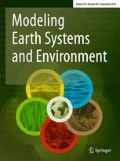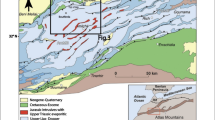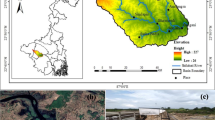Abstract
This study aims to map geological structures (lineaments) which are indications of sustainable groundwater supply in a hard rock terrain of Akoko-Edo local government area of Edo State, Nigeria. Landsat-OLI imagery, topographical map and geological map of Nigeria were used for this study. The methodology involves subjecting the imagery to preprocessing algorithms, linear/edge enhancement, directional filtering, contrast stretching using ENVI 4.7 software. The lineaments were extracted automatically using PCI Geomatica software while ArcGIS and Rockworks software were used to plot the lineament density map and lineament trend respectively. The result shows the total number and length of lineaments to be 197 and 278.85 km respectively. Shorter lineaments constitute about 40% of the total number of lineaments. The lineaments density varies from 0 to 2.40 km/sq.km, and areas with 1.32–2.40 km/sq.km and 0.82 km/sq.km reflect high and moderate degree of rock fracturing which makes these areas suitable target for groundwater exploitation as they possess more lineaments. The lineament trend results showed two prominent trends E–W, N–S and ENE–WSW. Other minor trends are also observed in the study area. These trends validate with results of earlier local studies and with directions of prominent geological structures and features of the study area. The discovery and delineation of the geological structures (lineaments) will serve as direct guides for decision makers to accurately site productive boreholes that will solve the problem of water scarcity in the study area, thereby promoting good developmental policy.
Similar content being viewed by others
References
Abdullahi BU, Rai JK, Momoh M, Udensi EE (2013) Effect of lineaments on groundwater occurrence. Int J Environ Bioenergy 8(1):22–32
Acharya T, Basumallik S, Paul SK (2007) Comparative analysis of lineaments and fractures in Precambrian crystalline rocks using remote sensing and field technique: A case study in and around Balarampur, Purulia District, West Bengal, India. In: Abstract, Proc. International Conference on Precambrian Sedimentation and Tectonics and Second GPSS Meeting, 10–12 December 2007, IIT Bombay, Mumbai, pp 68–69
Agunleti YS, Arikawe EA, Okegye JIK, Fadele SI (2014) Structural analysis of digitized lineament from satellite imagery and vertical electrical soundings (VES) studies for ground water exploration in part of Nasarawa state. Pac J Sci Technol 15(1):345–354
Akinwumiju AS, Olorunfemi MO, Afolabi O (2016) Automated lineament mapping from remotely sensed data: case study osun drainage basin, Southwestern Nigeria. Ife J Sci 18(1):177–201
Amigun JO, Faruwa RA, Komolafe AA (2015) Integrated Landsat imagery and geophysical exploration for groundwater potential evaluation of Okene and its environs, Southwestern Nigeria. Int J Geosci 6:209–229
Bruning J, Gierke J, Maclean A (2011) An approach to lineament analysis for groundwater exploration in Nicaragua. Photogramm Eng Remote Sens 77(5):1–11
Edet AE, Teme CS, Okereke CS, Esu EO (1994) Lineament analysis for groundwater exploration in Precambrian Oban Massif and Obudu Plateau, SE Nigeria. J Min Geol 30(1):87–95
Jordan G, Meijninger BML, Van Hinsbergen DJJ, Meulenkamp JE, Van Dijk PM (2005) Extraction of morphotectonic features from DEMs: development and applications for study areas in Hungary and NW Greece. Int J Appl Earth Obs Geoinf 7:163–182
Kazemi R, Porhemmat J, Kheirkhah M (2009) Investigation of lineaments related to groundwater occurrence in a karstic area: a case study in Lar catchment, Iran. Res J Environ Sci 3(3):367–375
Mogaji K, Aboyeji O, Omosuyi G (2011) Mapping of lineaments for groundwater targeting in the basement complex region of Ondo State, Nigeria, using remote sensing and geographic information sys. Int J Water Res Environ Eng 3:150–160
Nigeria Geological Survey Agency (2006) The geological map of Nigeria. Authority of the Federal Republic of Nigeria
O’leary DW, Friedman JD, Pohn HA (1976) Lineaments, linear, lineations: Some proposed new standards for old terms. Geol Soc Am Bull 87:1463–1469
Oden MI, Udinmwen E (2014) Fracture characterization, mineral vein evolution and the tectonic pattern of IgarraSyn-Tectonic Granite, Southwestern Nigeria. Br J Appl Sci Technol 4(17):2417–2429
Odeyemi IB (1976) Prelimnary report on the field relationship of the Basement complex rocks around Igarra, Midwest Nigeria. In: Kogbe CA (ed) Geology of Nigeria, pp 59–63. Elizabeth Pub, Lagos
Oluyide PO (1988) Structural trends in the Nigerian basement complex. Precambrian geology of Nigeria. Geological Survey of Nigeria Publication, Kaduna, pp 93–98
Onyedim GC, Ocan OO (2001) Correlation of SPOT imagery lineaments with geological fractures in parts of Ilesha Area, Southwestern Nigeria. J Min Geol 37(1):15–22
Oyawoye MO (1972) The basement geology of Nigeria. In: African Geology Ibadan 1970 (eds) Dessauvagie and Whiteman. Geology Department, University of Ibadan, Nigeria, pp 67–99
Rahaman MA (1976) Review of the basement geology of SW Nigeria in Geology of Nigeria. Elizabithan Publishing Company, Nigeria, pp 41–58
Rahaman MA (1988) Recent advances in the study of the basement complex of Nigeria. Precambrian geology of Nigeria. Geological Survey of Nigeria, Kaduna South, pp 11–43
Rahiman TIH, Pettinga JR (2008) Analysis of lineaments and their relationship to Neogene fracturing, SE Viti Levu, Fiji. Geol Soc Am Bull 120(11–12):1544–1555
Ramsay JG, Huber MI (1987) The techniques of modern structural geology. Folds and fractures, vol 2, xi + 391. Academic Press, Cambridge
Rao NS, Chakradhar GKJ, Srinivas V (2001) Identification of groundwater potential zones using remote sensing techniques in and around Guntur Town, Andhra Pradesh, India. J Indian Soc Remote Sens 29:69
Reddy GPOBI, Mouli KC, Srivastav SK, Srinivas CV, Maji AK (2000) Evaluation of ground water potential zones using remote sensing data—a case study of Gaimukh Watershed, Bhandard District, Maharashtra. J Indian Soc Remote Sens 28:19–32
Sabins FF (1996) Remote sensing: principles and interpretation, 3rd edn. W. H. Freeman and Company, New York, p 494
Sankar K (2002) Evaluation of groundwater potential zones using remote sensing data In Upper Vaigai River Basin, Tamil Nadu, India. J Indian Soc Remote Sens 30(3):119–129
Stefouli M, Angellopoulos A, Perantonis S, Vassilas N, Ambazis N, Charou E (1996) Integrated analysis and use of remotely sensed data for the seismic risk assessment of the southwest Peloponessus Greece. In: First Congress of the Balkan Geophysical Society, 23–27 September, Athens Greece
Yassaghi A (2006) Integration of Landsat imagery interpretation and geomagnetic data on verification of deep-seated transverse fault lineaments in SE Zagrosa, Iran. Int J Remote Sens 27:4529–4544
Acknowledgements
The authors are grateful for the support received from staff and post-graduate students at the Department of Geology, University of Nigeria, Nsukka during the course of this research. We are also grateful for the competency-development support our international partners (such as the International Consortium on Landslides, and International Consortium on Geo-disaster Reduction) offered us throughout the duration of the work.
Author information
Authors and Affiliations
Corresponding author
Rights and permissions
About this article
Cite this article
Aluko, O.E., Igwe, O. Automated Geological lineaments mapping for groundwater exploration in the basement complex terrain of Akoko-Edo area, Edo-State Nigeria using remote sensing techniques. Model. Earth Syst. Environ. 4, 1527–1536 (2018). https://doi.org/10.1007/s40808-018-0511-4
Received:
Accepted:
Published:
Issue Date:
DOI: https://doi.org/10.1007/s40808-018-0511-4














